Learn how to make the popular deep-fried Indian flatbread poori or puri with detailed step-wise pictures. Puffy and non-oily poori recipe!
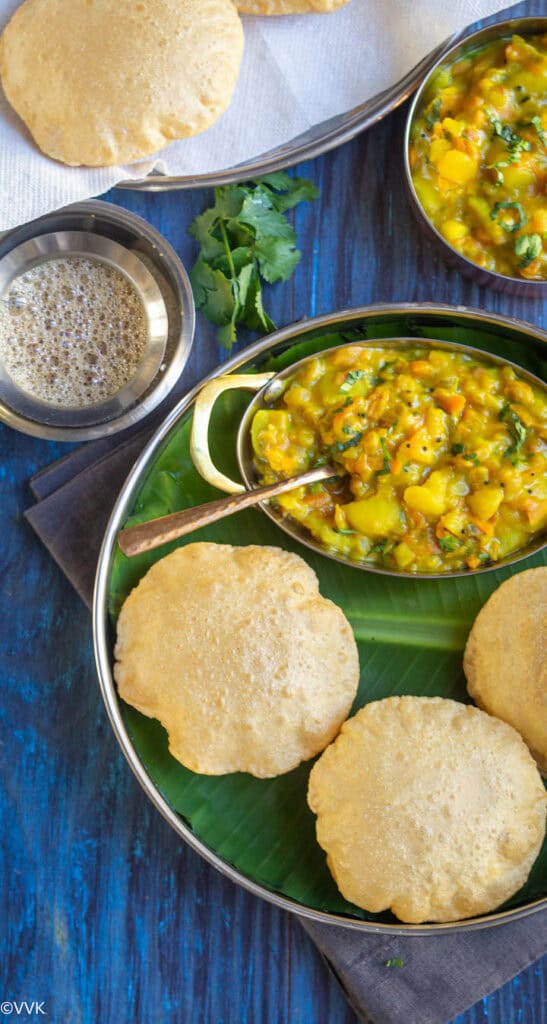
Poori is one of my favorite dishes. My mom still recollects how I love poori and onion rice and uses them as bait to entice me. Guess what? Both poori and onion rice are my son’s favorite dishes too. While onion rice is our lunch box staple, poori is mostly our weekend staple.
Jump to:
Poori | puri
Poori or puri is a deep-fried unleavened flatbread made with wheat flour that’s quite popular across the Indian subcontinent. While it’s a typical breakfast dish in South India, in my opinion, you can relish it for any meal. You can find poori as part of Indian thali/meal plates as well.
I can hear you asking why it took this long to post it here on my blog? Somehow I missed posting the basic recipes. I am slowly posting them all one by one. (As you all know, I posted the idli dosa batter, tamarind paste last year.)
Poori with other flours | Variations
The other reason for the delay in posting this recipe is, I always keep experimenting with basic recipes, and every time I make poori, I add different flours and keep changing the proportions, etc. I have already shared beets poori and poori with other flours on my Instagram. Please find the links below.
And I received a lot of requests to share them on the blog. But before that, I wanted to share the basic poori recipe, so here I am finally sharing the same.
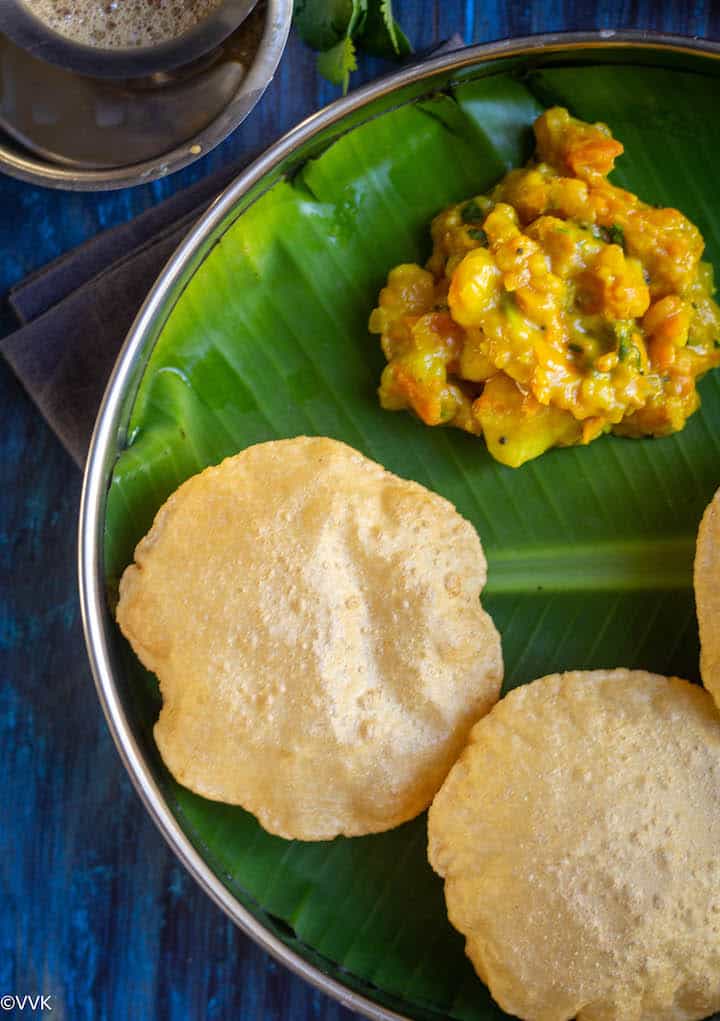
Ingredients required for making poori
You need four main ingredients – wheat flour, water, salt, and oil for frying poori. All the other ingredients are optional, and I will explain why I add them.
Optional ingredients
All-purpose flour or maida: I tried poori with half and half wheat and all-purpose flour at my friend’s place, and I liked the flavor, and it doesn’t make the poori oily. So I started adding that, but I add only 1 tbsp of all-purpose flour for 1 cup of wheat flour. You can skip it or increase the amount.
Semolina: Adding sooji or semolina adds light, crispy texture and keeps the poori puffy for a longer time, not hours, though. :-) I learned this trick from my friend, and I use fine semolina for my poori. I add about ½ tbsp of semolina for every 1 cup of wheat flour. You can add up to 1 tbsp but not more.
Sugar: Sugar yields lovely golden brown pooris. ¼ to ½ tsp for a cup of wheat flour should do.
Tips for puffy and non-oily pooris
- Firm and stiff dough – Make stiff and tight/firm dough for poori. The dough should not be soft like chapati. If the dough is soft, pooris absorb oil. So be cautious while adding water. At the same time, the dough should not be too dry and crumbly.
- Resting the dough – Do not rest the dough for a longer time. I let it sit for a maximum of 15 minutes. But not more than that.
- The thickness of the poori – Do not roll the poori too thin nor too thick. Fret not; it comes with practice. As you can see from the pictures, my poori is not a perfect circle. Don’t worry about the shape; make sure you roll it evenly.
- Should we dust the poori with oil or flour? I add a little bit of oil while kneading the dough and use flour while rolling the poori. So far I haven’t faced any problems, but my SIL uses oil while rolling the poori. I have tried, but somehow I prefer flour and use the same for dusting.
- Oil temperature while frying – The oil should be at the right temperature for frying the poori. To test, drop a small piece of the dough into the hot oil. If it rises immediately, then it’s at the right temperature. Make sure the dough doesn’t brown up, then the oil is too hot. Always deep-fry the poori over medium heat. If you fry at high heat or very low heat, the poori will absorb oil. So as you roll and deep-fry, adjust the heat and make sure the oil is at the right temperature.
- For puffy poori: While frying the poori, gently press the poori with the slotted spoon’s back, and it helps the poori to puff. You can see that on my IG videos. Also, try not to stack the pooris after frying.
Dietary Specifications and serving suggestions
As you can see from the ingredients list, poori is a vegan dish but not gluten-free. If you are using sugar, make sure you are using the vegan one.
Now coming to the serving suggestions, IMO, poori, kizhangu, or the potato masala is a combo made in heaven. But that’s not the only side dish for poori.
Some of the side dishes that you can pair it with are,
Coconut chutney: Yes, you heard it right. Coconut chutney pairs well with poori. When we have to skip onion, my mom makes coconut chutney, and we love it.
Kurma: You can serve poori with any type of kurma like turnip kurma or mixed veg kurma or green peas kurma.
Some of the other side dishes for poori that are popular in India are undhiyu, amrakhand, chana masala, Pindi chole, and many more.
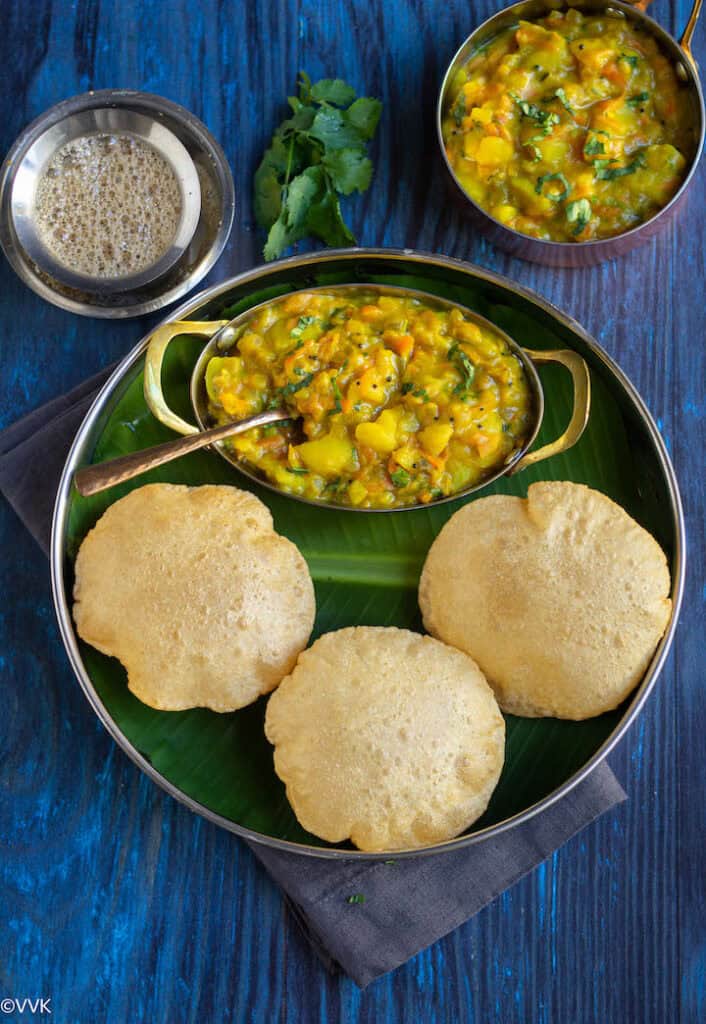
Leftover pooris???
Poori is excellent when served hot. But guess what, cold pooris are great too. My husband loves to relish cold pooris soaked in warm milk with sugar. I purposefully save a couple of pooris for him to enjoy with milk.
If you are a big fan of chalupa, a delicacy from Mexico, you can make some fusion chalupas with leftover pooris. Top your pooris with refried beans, lettuce, sour cream, and salsa, and enjoy!
Ok, I think I wrote a lot. Now without any further ado, let’s see the step-wise poori recipe.
Poori recipe with step-wise pictures
Prepare the dough
- I prepared my dough in the Nutril mill artiste. You can prepare it with any stand mixer or knead it by hand also. If you are using the stand mixer, follow the instructions accordingly. Add the wheat flour, all-purpose flour, salt, sugar, semolina, and oil.
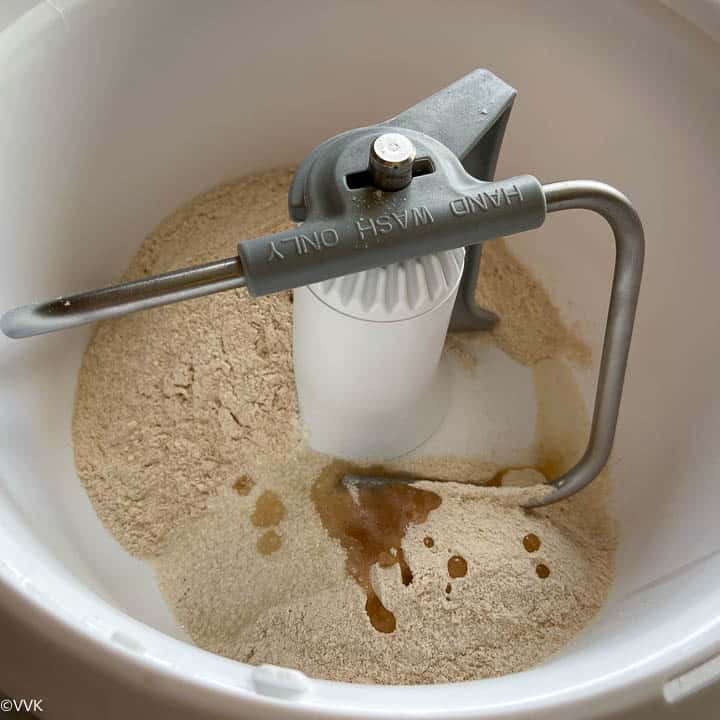
- I first added ½ cup of water and mixed it using pulse mode. Then I knead the dough at speed 3 or 4 for 5 to 7 minutes. If needed, I add water on a required basis. Overall I used 1.25 cups of water.
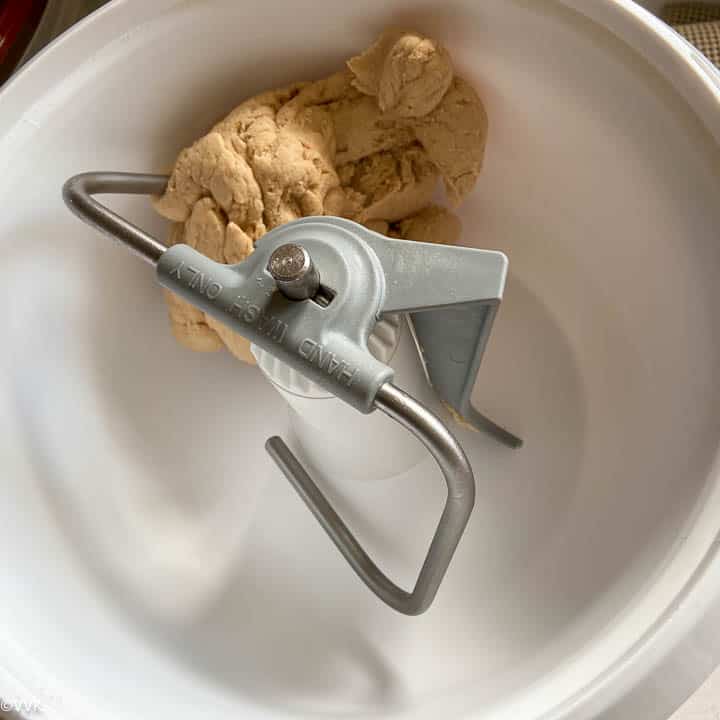
- After kneading, remove the dough from the mixer bowl and gently knead and smoothen it.
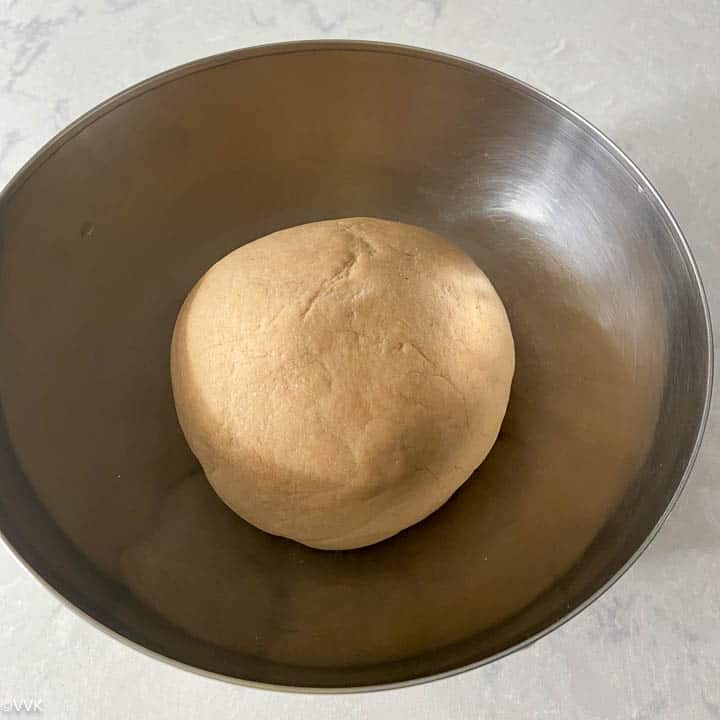
- Divide the prepared dough into equal parts and roll them into smooth balls. I got about 18 balls.

Roll the poori & Heat the oil
- On a dusted surface, take one ball and roll it out into a small circle, 3 to 4 inches in diameter. Do not roll it too thin or too thick.
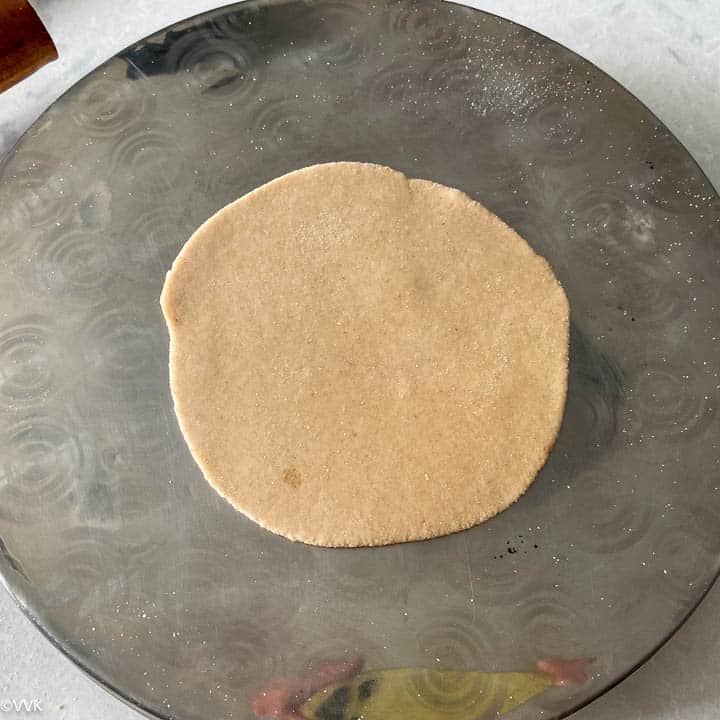
- Parallelly you can heat the oil for frying the poori over medium heat.
Fry the poori
- Test the oil temperature by dropping a small piece of the dough, and if it rises immediately, then the oil is ready. Gently drop the rolled poori into the hot oil.
- Let it sizzle for few seconds, and slowly the poori will puff up. You can gently press the poori with the back of the slotted spoon so that it puffs up evenly.
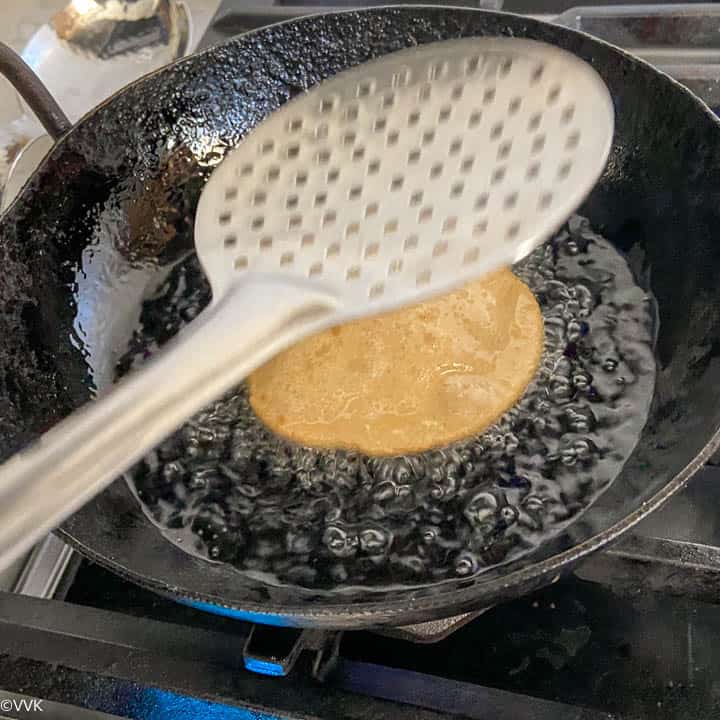
- Once it is fully puffed, carefully flip the poori and cook it turns light golden brown. Do not overcook the poori; it will become crisp and hard.
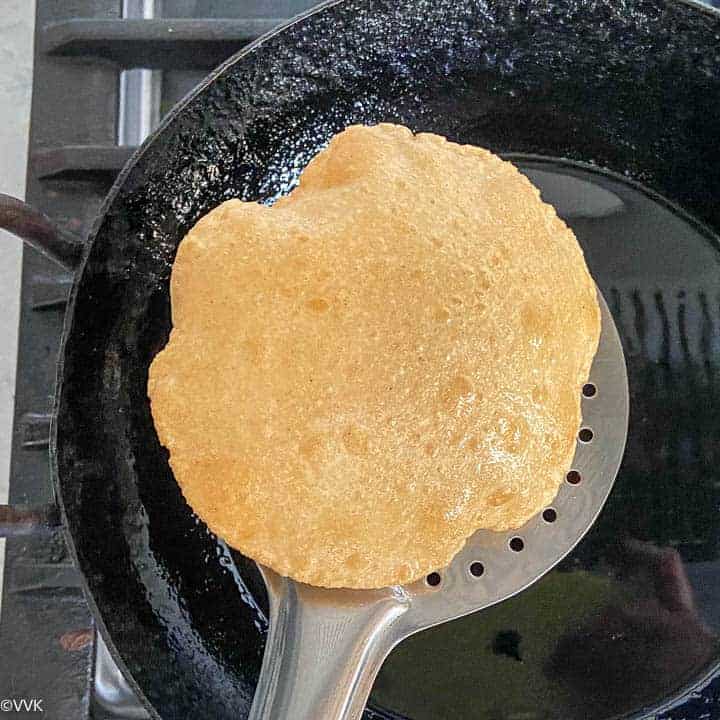
- Remove the poori from the oil and place it on tissue paper or parchment paper to drain the excess oil. Similarly, fry the remaining pooris.
- Serve the poori hot with a side dish of your choice like potato masala, kurma, or chutney.
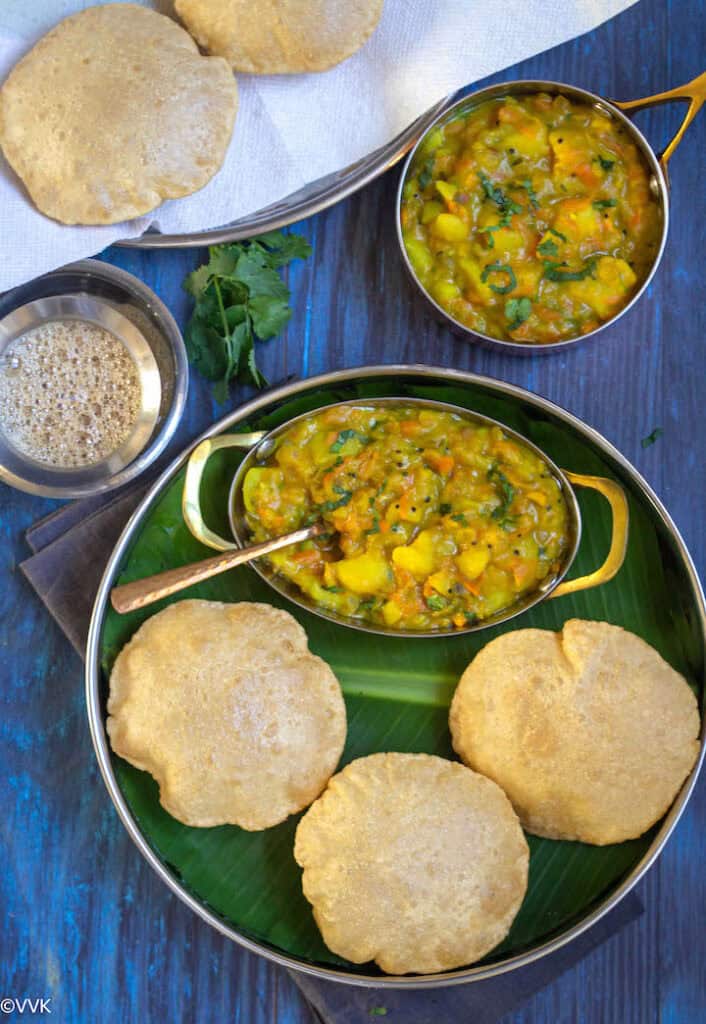
Recipe Notes
- The water measure differs depending upon the flour quality and variety. So add as required. The dough should be firm and tight. For this recipe, I use Khazana organic wheat flour and Organic choice all-purpose flour. (Not sponsored)
- I get help from my family when preparing poori. I usually roll, and my husband does the frying part. You can roll all the balls and then start frying and make sure you cover the rolled poori. Alternatively, you can roll and fry in batches. In that case, make sure the oil temperature is correct and adjust the heat accordingly.
- This measure yields about 15 to 18 pooris depending on how you divide the dough.
- I have provided all the other tips above; please refer to the tips section for the same.
More Indian Breads
PS: Follow me on Instagram or join my Facebook Group for more gardening and recipe updates. If you try this poori recipe or any other variations as mentioned, please don’t forget to comment and rate this recipe. If you have any questions, please leave a comment, and I will get to it asap. Make sure to follow me on my Pinterest for more healthy and delicious ideas!
📖 Recipe
Poori | Puri | How To Make Poori | Deep-Fried Indian Bread
Equipment
- Mixing bowl
- Rolling board and pin
- Kadai or frying pan
Ingredients
Measurement Details: 1 cup =240ml; 1 tbsp = 15ml; 1 tsp = 5ml;
- 3 cups whole wheat flour
- 3 tbsp all-purpose flour optional
- 1.5 tsp sugar optional
- 1 tsp salt heaped or to taste
- 1.5 tbsp semolina optional
- 1.5 tsp oil
- 1.25 cups water or as required
- 1.5 cups oil for frying
Instructions
Prepare the dough
- I prepared my dough in the Nutril mill artiste. You can prepare it with any stand mixer or knead it by hand also. If you are using the stand mixer, follow the instructions accordingly. Add the wheat flour, all-purpose flour, salt, sugar, semolina, and oil.
- I first added ½ cup of water and mixed it using pulse mode. Then I knead the dough at speed 3 or 4 for 5 to 7 minutes. If needed, I add water on a required basis. Overall I used 1.25 cups of water.
- After kneading, remove the dough from the mixer bowl and gently knead and smoothen it.
- Divide the prepared dough into equal parts and roll them into smooth balls. I got about 18 balls.
Roll the poori & Heat the oil
- On a dusted surface, take one ball and roll it out into a small circle, 3 to 4 inches in diameter. Do not roll it too thin or too thick. Parallelly you can heat the oil for frying the poori over medium heat.
Fry the poori
- Test the oil temperature by dropping a small piece of the dough, and if it rises immediately, then the oil is ready. Gently drop the rolled poori into the hot oil. Let it sizzle for few seconds, and slowly the poori will puff up. You can gently press the poori with the back of the slotted spoon so that it puffs up evenly.
- Once it is fully puffed, carefully flip the poori and cook it turns light golden brown. Do not overcook the poori; it will become crisp and hard.
- Remove the poori from the oil and place it on tissue paper or parchment paper to drain the excess oil. Similarly, fry the remaining pooris. Serve the poori hot with a side dish of your choice like potato masala, kurma, or chutney.
Notes
- The water measure differs depending upon the flour quality and variety. So add as required. The dough should be firm and tight. For this recipe, I use Khazana organic wheat flour and Organic choice all-purpose flour. (Not sponsored)
- I get help from my family when preparing poori. I usually roll, and my husband does the frying part. You can roll all the balls and then start frying and make sure you cover the rolled poori. Alternatively, you can roll and fry in batches. In that case, make sure the oil temperature is correct and adjust the heat accordingly.
- This measure yields about 15 to 18 pooris depending on how you divide the dough.
- I have provided all the other tips above; please refer to the tips section for the same.
Nutrition
I am not a nutritionist. The nutritional information is provided as a courtesy and is an estimate only. It varies depending upon the product types or brands.


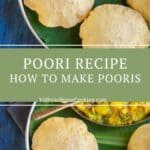
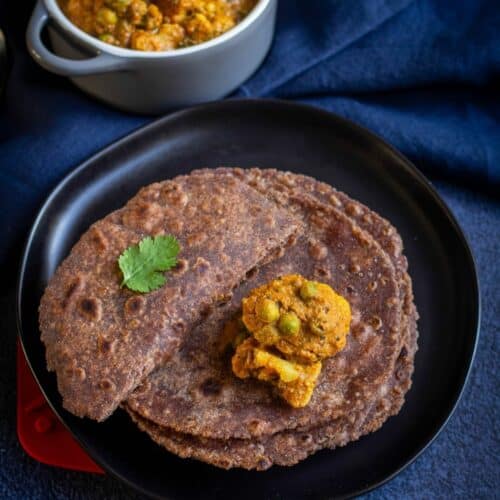
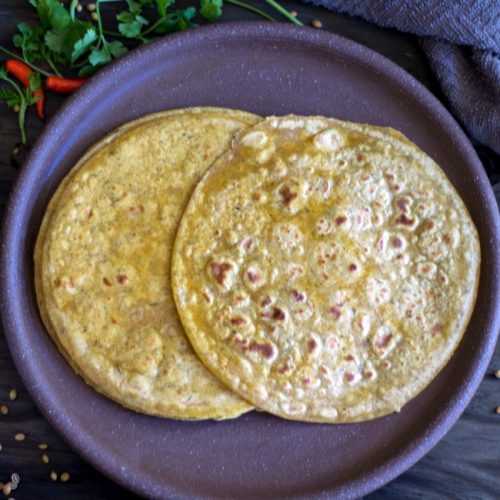
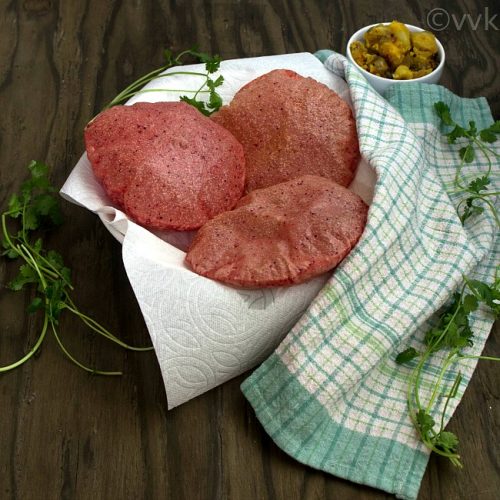
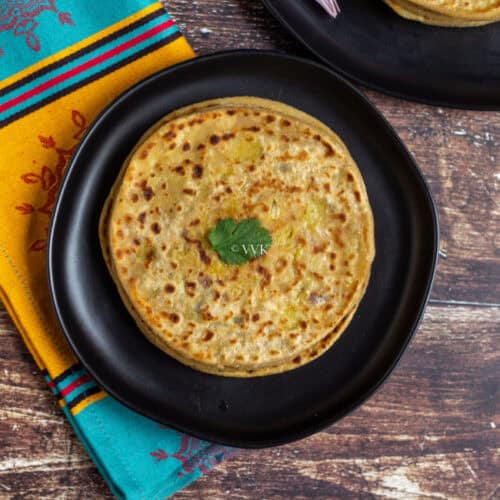
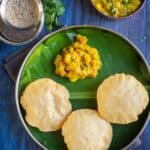
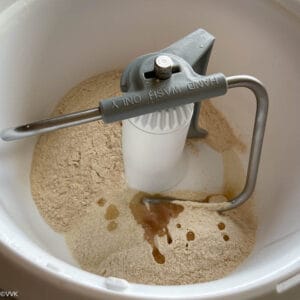
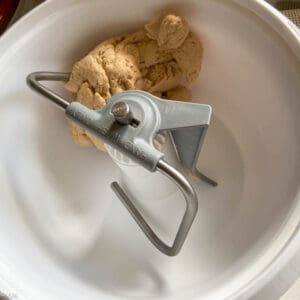
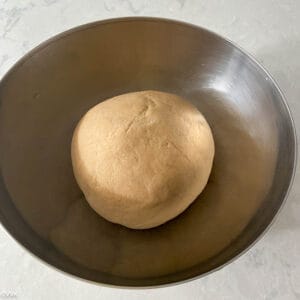
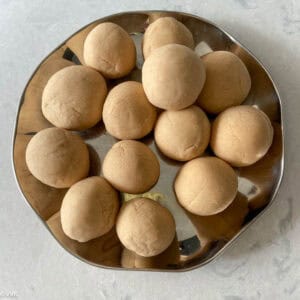
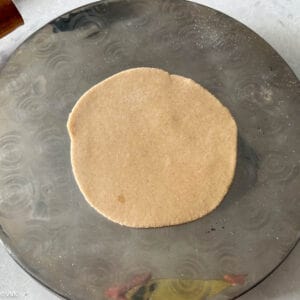
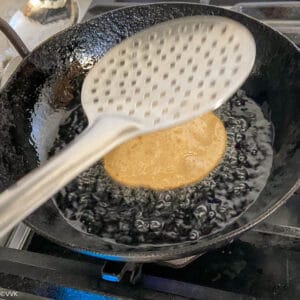
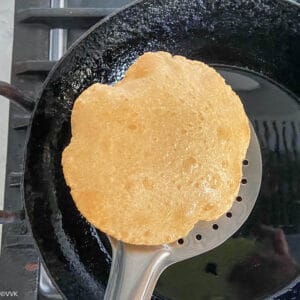
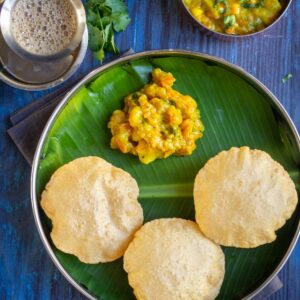
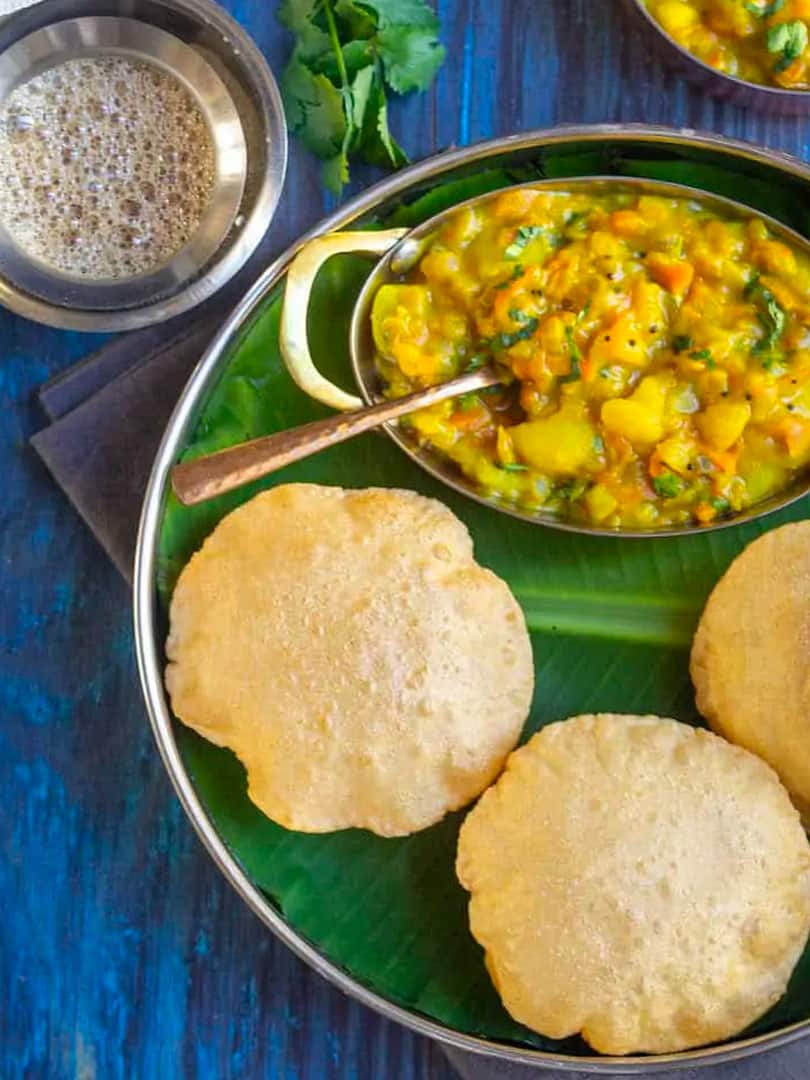

i would like to use white plain flour fo poori. please let me know if i can
Yes you can definitely use.
Dear Vidya.. Wonderful sharing the golden olden day – (mostly modified in these days), Good getting back to basics – 101’s..
Pls can you let us know the dough mixer brand / model #..
Appreciated.
Thanks a lot. The one that I am using is the Nutrimill Artiste. Here is the amazon link – https://amzn.to/3sMNVzP